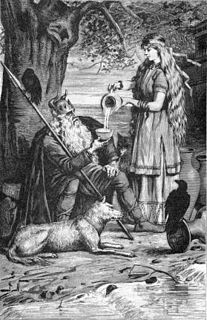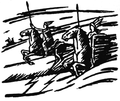
In Norse mythology, Rán is a goddess and a personification of the sea. Rán and her husband Ægir, a jötunn who also personifies the sea, have nine daughters, who personify waves. The goddess is frequently associated with a net, which she uses to capture sea-goers. According to the prose introduction to a poem in the Poetic Edda and in Völsunga saga, Rán once loaned her net to the god Loki.

In Norse mythology, Eir is a goddess or valkyrie associated with medical skill. Eir is attested in the Poetic Edda, compiled in the 13th century from earlier traditional sources; the Prose Edda, written in the 13th century by Snorri Sturluson; and in skaldic poetry, including a runic inscription from Bergen, Norway from around 1300. Scholars have theorized about whether these three sources refer to the same figure, and debate whether Eir may have been originally a healing goddess or a valkyrie. In addition, Eir has been theorized as a form of the goddess Frigg and has been compared to the Greek goddess Hygieia.

In Norse mythology, Snotra is a goddess associated with wisdom. Snotra is solely attested in the Prose Edda, written in the 13th century by Snorri Sturluson. Scholars have proposed theories about the implications of the goddess.
In Norse mythology, Vör is a goddess associated with wisdom. Vör is attested in the Prose Edda, written in the 13th century by Snorri Sturluson; and twice in kennings employed in skaldic poetry. Scholars have proposed theories about the implications of the goddess.
In Norse mythology, a valkyrie is one of a host of female figures who choose those who may die in battle and those who may live. Selecting among half of those who die in battle, the valkyries bring their chosen to the afterlife hall of the slain, Valhalla, ruled over by the god Odin. There, the deceased warriors become einherjar. When the einherjar are not preparing for the events of Ragnarök, the valkyries bear them mead. Valkyries also appear as lovers of heroes and other mortals, where they are sometimes described as the daughters of royalty, sometimes accompanied by ravens and sometimes connected to swans or horses.

In Norse mythology, the Nine Mothers of Heimdallr are nine sisters who gave birth to the god Heimdallr. The Nine Mothers of Heimdallr are attested in the Prose Edda, written in the 13th century by Snorri Sturluson; in the poetry of skalds; and possibly also in a poem in the Poetic Edda, a book of poetry compiled in the 13th century from earlier traditional material. Scholars have debated what being "born of nine mothers" implies and have sought to connect the notion to other European folk motifs. Scholars have theorized that Heimdallr's Nine Mothers may be identical to the Nine Daughters of Ægir and Rán, who personify waves. In turn, Heimdallr would be born of the sea.

In Norse mythology, Gullveig is a being who was speared by the Æsir, burnt three times, and yet thrice reborn. Upon her third rebirth, Gullveig's name becomes Heiðr and she is described as a knowledgeable and skillful völva. Gullveig/Heiðr is solely attested in the Poetic Edda, compiled in the 13th century from earlier traditional material. Scholars have variously proposed that Gullveig/Heiðr is the same figure as the goddess Freyja, that Gullveig's death may have been connected to corruption by way of gold among the Æsir, and/or that Gullveig's treatment by the Æsir may have led to the Æsir–Vanir War.
In Norse mythology, Hoddmímis holt is a location where Líf and Lífþrasir are foretold to survive the long winters of Fimbulvetr. Hoddmímis holt is attested in the Poetic Edda, compiled in the 13th century from earlier traditional sources, and the Prose Edda, written in the 13th century by Snorri Sturluson. Scholarly theories have been proposed about the location and its potential connection to the world tree Yggdrasil and folktales recorded from Germanic Europe.

In Norse mythology, Ýdalir ("yew-dales") is a location containing a dwelling owned by the god Ullr. Ýdalir is solely attested in the Poetic Edda, compiled in the 13th century from earlier traditional sources. Scholarly theories have been proposed about the implications of the location.
In Norse mythology, Gulltoppr is one of the horses of the gods. Gulltoppr is mentioned in a list of horses in the Poetic Edda poem Grímnismál and in Nafnaþulur section of the Prose Edda. According to Prose Edda book Gylfaginning, he is the horse of Heimdallr. Rudolf Simek theorizes that Snorri assigned a horse to Heimdallr in an attempt to systematize the mythology.

In Norse mythology, the goddess Rán and the jötunn Ægir both personify the sea, and together they have nine daughters who personify waves. Each daughter's name reflects poetic terms for waves. The sisters are attested in the Poetic Edda, compiled in the 13th century from earlier traditional sources; the Prose Edda, written in the 13th century by Snorri Sturluson; and in the poetry of skalds. Scholars have theorized that these daughters may be the same figures as the nine mothers of the god Heimdallr.

In Norse mythology, Líf and Lífþrasir, sometimes anglicized as Lif and Lifthrasir—female and male respectively—are two humans who are foretold to survive the events of Ragnarök by hiding in a wood called Hoddmímis holt, and after the flames have abated, to repopulate the newly risen and fertile world. Líf and Lífþrasir are mentioned in the Poetic Edda, compiled in the thirteenth century from earlier traditional sources, and the Prose Edda, written in the 13th century by Snorri Sturluson. Scholarly theories have been proposed about the underlying meaning and origins of the two names.
In Norse mythology, Kára is a valkyrie, attested in the prose epilogue of the Poetic Edda poem Helgakviða Hundingsbana II.

In Norse mythology, Sága is a goddess associated with the wisdom Sökkvabekkr. At Sökkvabekkr, Sága and the god Odin merrily drink as cool waves flow. Both Sága and Sökkvabekkr are attested in the Poetic Edda, compiled in the 13th century from earlier traditional sources, and in the Prose Edda, written in the 13th century by Snorri Sturluson. Scholars have proposed theories about the implications of the goddess and her associated location, including that the location may be connected to the goddess Frigg's fen residence Fensalir and that Sága may be another name for Frigg.
In Norse mythology, Hlaðguðr svanhvít is a valkyrie. Hlaðguðr svanhvít is attested in the Poetic Edda poem Völundarkviða as the sister of the valkyrie Hervör alvitr, and as the seven-year wife of Slagfiðr.
In Norse mythology, Svipul is a valkyrie. Svipul is attested among valkyrie list in the poem Darraðarljóð and the longer of the two Nafnaþulur valkyrie lists in the Poetic Edda book Skáldskaparmál. In addition, the name Svipul appears as a synonym for "battle" in Skáldskaparmál. Rudolf Simek theorizes that the name Svipul presumably refers to the changeable nature of fate, whose directors the valkyries are represented as being, especially in Darraðarljóð.

In Norse mythology, Herfjötur is a valkyrie. Herfjötur is attested as among the 13 valkyries listed in the Poetic Edda poem Grímnismál, and in the longer of the two Nafnaþulur lists found in the Prose Edda.

Agnarr Geirröðsson is the son of King Geirröðr in Norse mythology. Agnarr is solely attested in the poem Grímnismál in the Poetic Edda, the latter compiled in the 13th century from earlier traditional sources. In Grímnismál he is described as aiding Odin, disguised as Grímnir, to escape from Geirröðr's torture.

In Norse mythology, the Kerlaugar i.e. "bath-tub", are two rivers through which the god Thor wades. The Kerlaugar are attested in the Poetic Edda, compiled in the 13th century from earlier traditional material, and in a citation of the same verse in the Prose Edda, written in the 13th century by Snorri Sturluson.

















